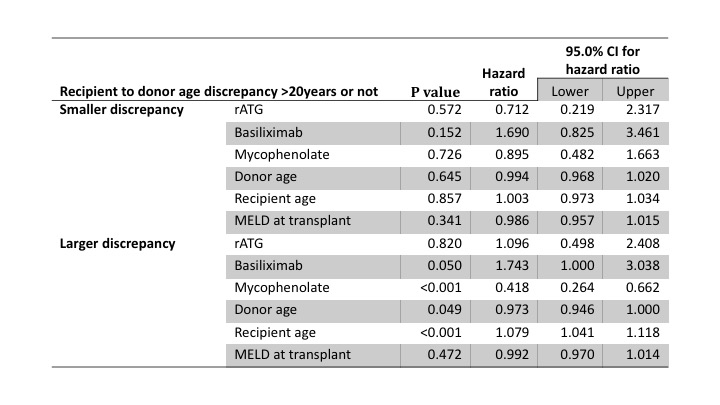Fatal Graft versus Host Disease in Liver Transplantation. An Analysis of UNOS Registry
1Transplant and Hepatobiliary Surgery, Henry Ford Hospital, Detroit, MI, 2Gastroenterology, Henry Ford Hospital, Detroit, MI
Meeting: 2019 American Transplant Congress
Abstract number: D131
Keywords: Age factors, Immunosuppression, Induction therapy, Mortality
Session Information
Session Name: Poster Session D: Liver: Immunosuppression and Rejection
Session Type: Poster Session
Date: Tuesday, June 4, 2019
Session Time: 6:00pm-7:00pm
 Presentation Time: 6:00pm-7:00pm
Presentation Time: 6:00pm-7:00pm
Location: Hall C & D
*Purpose: Graft-versus-host disease (GVHD) after liver transplant is a rare complication. This study aimed to analyze the UNOS registry to identify risk factors for fatal GVHD, focusing on effects of immunosuppression regimens.
*Methods: We used the UNOS registry. All adult liver transplant and liver-kidney transplant patients between 2002 and 2018 were analyzed. An endpoint was set as mortality due to GVHD. Patients who died within 30 days after transplant were excluded. We analyzed associations between GVHD and immunosuppression regimens, including induction and maintenance, along with other recipient and donor characteristics. Multivariate Cox regression model was used to analyze a risk of mortality due to GVHD.
*Results: A total of 77295 patients were eligible. There were 121 patients (0.2%) who died of GVHD. Rabbit-anti-thymocyte globulin (rATG) and basiliximab were used as induction in 7488 (9.7%) and 11736 (15.2%). Mycophenolate was used as maintenance in 53309 (68.9%). Donor-to-recipient age discrepancy (recipient age – donor age) was an independent risk factor (HR 1.03 [per year]; P<0.001). Based on a receiving operating characteristics curve analysis, a cut-off value of age discrepancy for prediction of fatal GVHD was 20 years (Area: 0.65, P<0.001). Incidence rate of fatal GVHD was 0.3% and 0.1% in the larger and smaller age discrepancy groups, respectively. On a multivariable model, hazard of fatal GVHD in the larger discrepancy group (>20 years) was 2.65, compared to a smaller discrepancy group (HR 2.65, P<0.001). Basiliximab (HR 1.76; P=0.011) remained as independent risk factors, whereas rATG was not associated (HR 1.03; P=0.93). Mycophenolate maintenance showed a protective effect (HR 0.55; P=0.001). A subgroup analysis in smaller and larger discrepancy groups showed that negative impact of basiliximab and positive impact of mycophenolate were found only in the larger age discrepancy group. In the larger discrepancy group, older recipient age and younger donor age were considered as independent risk factors, whereas neither remained as a risk factor in the smaller discrepancy group.
*Conclusions: Individualized immunosuppression regimens and donor selection by considering age discrepancy may be important to decrease a risk of GVHD. Avoiding Basiliximab induction and adding Mycophenolate to maintenance may be favorable regimens.
To cite this abstract in AMA style:
Nagai S, Yoshida A, Salgia R, Abouljoud M, Moonka D. Fatal Graft versus Host Disease in Liver Transplantation. An Analysis of UNOS Registry [abstract]. Am J Transplant. 2019; 19 (suppl 3). https://atcmeetingabstracts.com/abstract/fatal-graft-versus-host-disease-in-liver-transplantation-an-analysis-of-unos-registry/. Accessed December 19, 2025.« Back to 2019 American Transplant Congress

